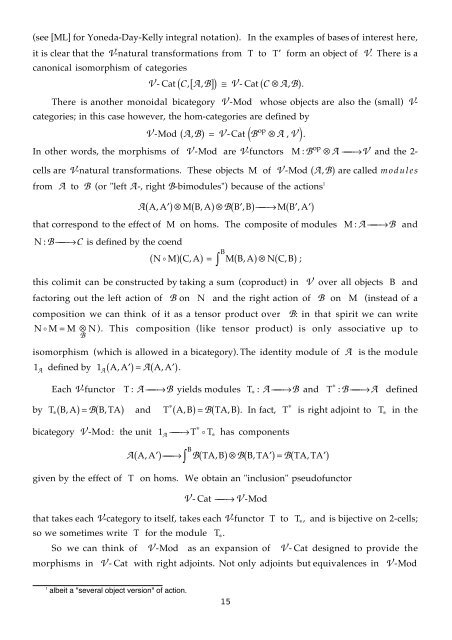Frobenius monads and pseudomonoids Introduction - ResearchGate
Frobenius monads and pseudomonoids Introduction - ResearchGate
Frobenius monads and pseudomonoids Introduction - ResearchGate
You also want an ePaper? Increase the reach of your titles
YUMPU automatically turns print PDFs into web optimized ePapers that Google loves.
(see [ML] for Yoneda-Day-Kelly integral notation). In the examples of bases of interest here,<br />
it is clear that the V-natural transformations from T to T¢ canonical isomorphism of categories<br />
form an object of V. There is a<br />
V-Cat ( C, [ A, B] ) @ V-Cat ( C ƒA,<br />
B).<br />
There is another monoidal bicategory V -Mod whose objects are also the (small) Vcategories;<br />
in this case however, the hom-categories are defined by<br />
V-Mod ( A, B) op<br />
= V-Cat ( B ƒA<br />
, V ).<br />
In other words, the morphisms of V -Mod are V-functors M op<br />
: B ƒA æ æÆV <strong>and</strong> the 2-<br />
cells are V-natural transformations. These objects M of<br />
from A to B (or "left A-, right B-bimodules") because of the actions 1<br />
A AA , MBA , B B, B MB, A<br />
¢<br />
( ) ƒ ( ) ƒ ( ¢ ) æÆ æ ( ¢ ¢ )<br />
that correspond to the effect of M on homs. The composite of modules<br />
N:B C<br />
æÆ æ is defined by the coend<br />
B<br />
( NoM)( C, A) = M( B, A) ƒ N( C, B)<br />
;<br />
Ú<br />
V-Mod ( A, B)<br />
are called modules<br />
M:A B<br />
æÆ æ <strong>and</strong><br />
this colimit can be constructed by taking a sum (coproduct) in V over all objects B <strong>and</strong><br />
factoring out the left action of B on N <strong>and</strong> the right action of B on M (instead of a<br />
composition we can think of it as a tensor product over B: in that spirit we can write<br />
No M = M ƒN). This composition (like tensor product) is only associative up to<br />
B<br />
isomorphism (which is allowed in a bicategory). The identity module of A is the module<br />
1A defined by 1A ( AA , ¢ ) = A ( AA , ¢ ).<br />
by<br />
Each V-functor<br />
T B, A B B, TA <strong>and</strong><br />
*( ) = ( )<br />
bicategory<br />
V -Mod: the unit<br />
T: A æÆ æ B yields modules<br />
T *<br />
: A æÆ æ B <strong>and</strong><br />
T * : B æÆ æ A defined<br />
T A, B B TA, B . In fact, T * is right adjoint to T * in the<br />
* ( ) = ( )<br />
1A æÆ æ<br />
*<br />
T o T has components<br />
B<br />
*<br />
A( AA , ¢ ) æÆ æ B( TAB , ) ƒ B( BTA , ¢ ) = B(<br />
TA, TA¢<br />
)<br />
Ú<br />
given by the effect of T on homs. We obtain an "inclusion" pseudofunctor<br />
V-Cat V-Mod<br />
æÆ æ<br />
that takes each V-category to itself, takes each V-functor T to T * , <strong>and</strong> is bijective on 2-cells;<br />
so we sometimes write T for the module T * .<br />
So we can think of V -Mod as an expansion of V - Cat designed to provide the<br />
morphisms in V - Cat with right adjoints. Not only adjoints but equivalences in V -Mod<br />
1 albeit a "several object version" of action.<br />
15
















